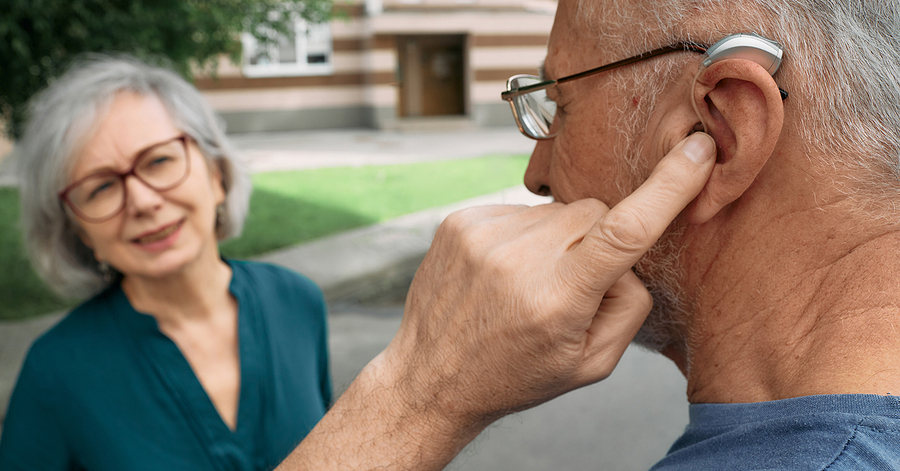I’m sorry, could you repeat that?
If that’s become your nagging refrain, it might be time for hearing aids. But getting hearing aids can feel like a big life transition. You might be full of questions.
What do hearing aids feel like? Will others be able to see them? How much will hearing aids help?
This hearing aid FAQ guide is here to answer your questions and put your mind at ease. After reading through it, you may feel more confident about making an appointment with a hearing aid professional.
How do I know I need hearing aids?
One of the most obvious signs of hearing loss is that you’re regularly asking others to repeat themselves. Being unable to track well in a group conversation is another key sign that something is amiss. Perhaps you’ve also noticed that you have to crank up the radio or the television louder than before.
The best way to find out whether you’re dealing with hearing loss is to visit a hearing expert. An audiologist is a healthcare professional who specializes in hearing. Becoming an audiologist requires earning a doctoral degree and becoming licensed.
At an audiologist’s office, you may have a hearing screening performed. The audiologist can also evaluate whether you are a good candidate for hearing aids.
How do hearing aids work?
In general, a hearing aid uses a tiny microphone to pick up sounds. The device then amplifies the sounds and delivers them to your ear through a built-in speaker.
Many of today’s hearing aids are a bit more sophisticated than that, though. Essentially, a modern hearing aid is a tiny, battery-powered computer. The internal computer quickly analyzes and processes the sounds based on your environment and your unique needs. That provides an enhanced listening experience.
What do hearing aids look like?
There are multiple hearing aid styles. Some are more noticeable to outside observers than others.
The least visible are completely-in-the-canal (CIC) hearing aids. They’re quite small, but they typically offer fewer features than other styles.
Often, the largest models are behind-the-ear (BTE) ones. They have a piece that sits in the ear and a hook that goes around it.
There are a number of different styles in between those two sizes. When picking out hearing aids, it’s best to consider not just appearances but also features and amplification capabilities.
What do hearing aids feel like?
You can have hearing aids custom-fit to the shape and size of your ears. Even still, there may be an adjustment period as you get used to wearing the devices. It can take a few days before having something in your ears feels normal.
Ask your hearing professional to show you how to properly insert and wear your hearing aids. Positioning them correctly can make a big difference in your comfort level.
At first, you may also be unsettled by how much more you can hear once you have hearing aids. Getting used to background noise can take several days. Your audiologist can provide tips for the adjustment phase.
Can hearing aids fully restore my hearing?
No hearing aid can fully recreate the natural hearing experience. Fortunately, though, many of today’s hearing aids do an excellent job of helping you listen to your surroundings and engage with the world.
Depending on the type and severity of your hearing loss, there may be other services of benefit to you. For example, a remote mic could provide an additional measure of hearing support in noisy environments.
Can I get away with just one hearing aid?
It’s typically best to have a hearing aid in each ear. That will give you the most balanced listening experience.
However, if one ear still has normal hearing, you’ll need only one hearing aid.
What powers hearing aids?
Hearing aids run on batteries.
Some hearing aids use batteries that can be recharged many times. The charger plugs into an outlet. You can place your hearing aids on the charger while you sleep.
Other models have batteries that must be replaced regularly. A set of disposable batteries may last about a week, give or take a few days.
What special features are available on hearing aids?
These days, consumers have more hearing aid options than ever before.
Some models pair with mobile apps. You can download a compatible app to your iPhone or Android device. From there, you’ll be able to control your hearing aids’ settings.
Additionally, some hearing aids customize your listening experience based on your environment. For example, models with multidirectional microphones can focus in on a speaker’s voice and reduce background noise.
There are also Bluetooth-enabled hearing aids. You might be able to pair them with your television or your phone for crystal-clear listening.
How much will I spend on hearing aids?
This is one of the most common hearing aid FAQ inquiries because people want to know if hearing help is something they can actually afford. There’s no cut-and-dry answer. Your out-of-pocket hearing aid price will depend on a variety of factors.
For one thing, there are so many different types of hearing aids. Basic models are usually less expensive. Those with bells and whistles typically cost more.
Some people’s health insurance includes coverage for hearing devices. Plus, audiology offices, such as North Shore Hearing, PC, may offer hearing aid discounts.
What is the next step?
Now that you’ve read through this hearing aid FAQ, is it time for you to pursue hearing assistance? If so, set an appointment with North Shore Hearing, PC. Audiologist Diane Faulknor and our other team members will help you learn more about hearing loss. We’ll also recommend the best solutions for your situation.We offer free hearing screenings, free hearing aid consultations and a range of other services. Contact us for an appointment today.


